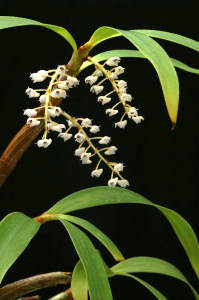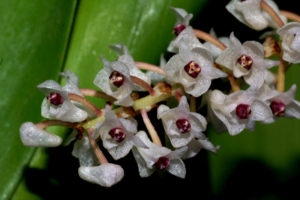The following article was written for the Orchid Species Bulletin published by the Orchid Species Society, which is based in Brisbane, Queensland in May 2005, updated in November 2010.
Bear in mind that any cultivation notes refer to the subtropical conditions of Southern Queensland, Australia.
 Pinalia floribunda (Lindl.) Kuntze was first described by John Lindley as Eria floribunda in the Botanical Register in 1844. The specific epithet comes from the Latin floribundus (profusely flowered) for the numerous many-flowered inflorescences. Carl Kuntze transferred this taxon to Pinalia in Revisio Generum Plantarum in 1891.
Pinalia floribunda (Lindl.) Kuntze was first described by John Lindley as Eria floribunda in the Botanical Register in 1844. The specific epithet comes from the Latin floribundus (profusely flowered) for the numerous many-flowered inflorescences. Carl Kuntze transferred this taxon to Pinalia in Revisio Generum Plantarum in 1891.
Recent DNA studies show that Eria is polyphyletic since it comprises species that are derived from different ancestors. Based on these studies, Phillip Cribb and Yan Peng Ng recognise Pinalia in Genera Orchidacearum, Volume 4 in 2005.
Pina. floribunda is an epiphytic or sometimes terrestrial plant that has clustered cylindrical stems that are 15-35 cm or more long and 8-10 mm in diameter. The stems bear 3-6 alternating two-ranked leaves near the apex. Variable in shape and size, the thin elliptical to narrowly lanceolate leaves are commonly 12-15 cm long and 1-2 cm broad but may be up to 30 cm long and 3.5 cm broad.

Usually 3-5 inflorescences are produced from the upper half of the recently matured stem at one time. Pendent or spreading horizontally, the inflorescences are 7-15 cm long (rarely up to 20 cm) and 1.5 cm in diameter with many resupinate flowers borne to the base of the raceme. Generally the flowers of Pina. floribunda are densely arranged along the rachis but may be more laxly spaced in some plants. Pale-brown-hairy to white-hairy on the outside, the small white flowers are 5-6 mm across and may be faintly tinged with pink. The top of the column and stigma are deep purple to maroon. Lasting for three to five days, the flowers produce sweet nectar from the base of the lip and have a brackish scent.
Widely distributed, Pina. floribunda is found from Myanmar, Thailand, Laos, Vietnam, Cambodia to Peninsular Malaysia, Sumatra, Borneo and the Philippines. This is a common lowland species but may be found in lower montane forests up to 1,300 m altitude. The fine roots of this species require a well-drained medium that is kept evenly moist, so water it often to ensure that the roots do not remain dry for long periods. Grow it under about 70% shade with high humidity and good air circulation. Pina. floribunda seems to do best with a winter minimum of 12 oC, otherwise leaf drop occurs if temperatures remain low for long periods.
